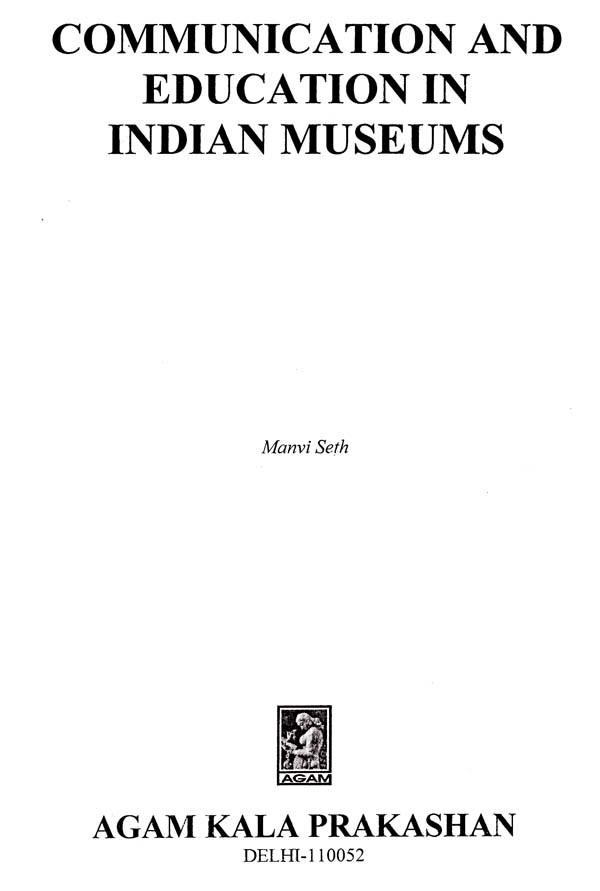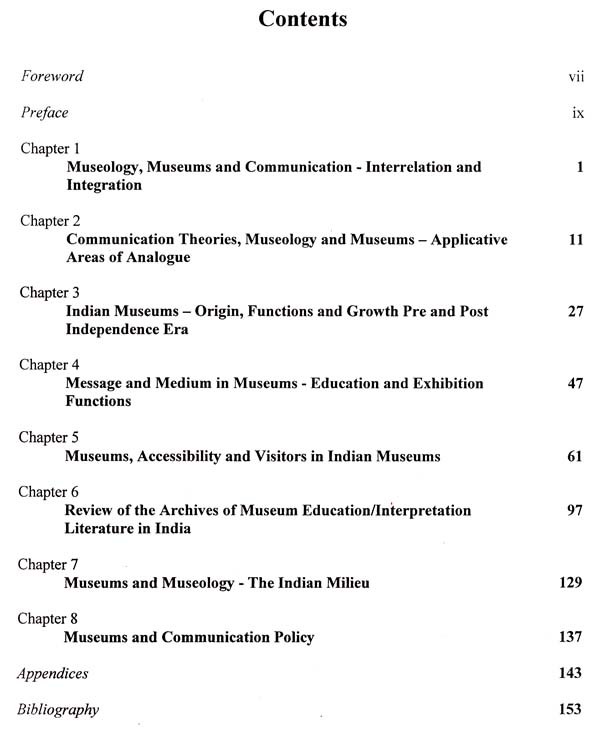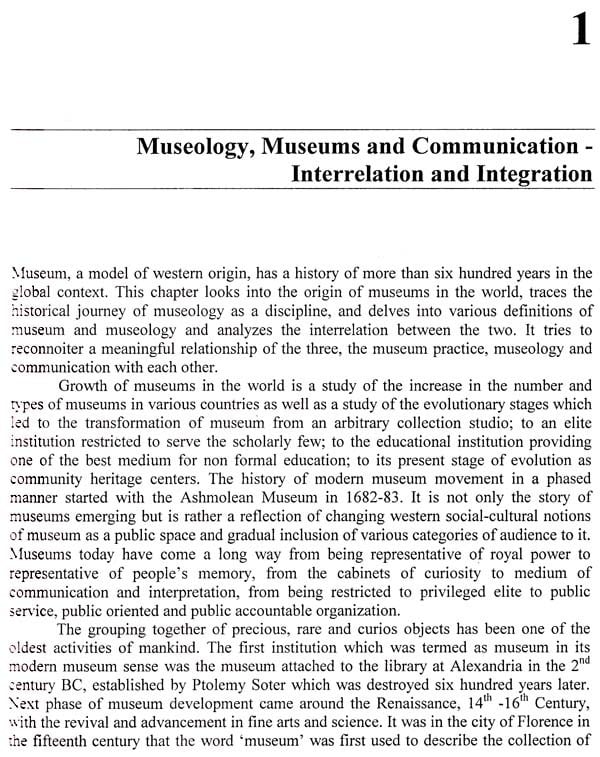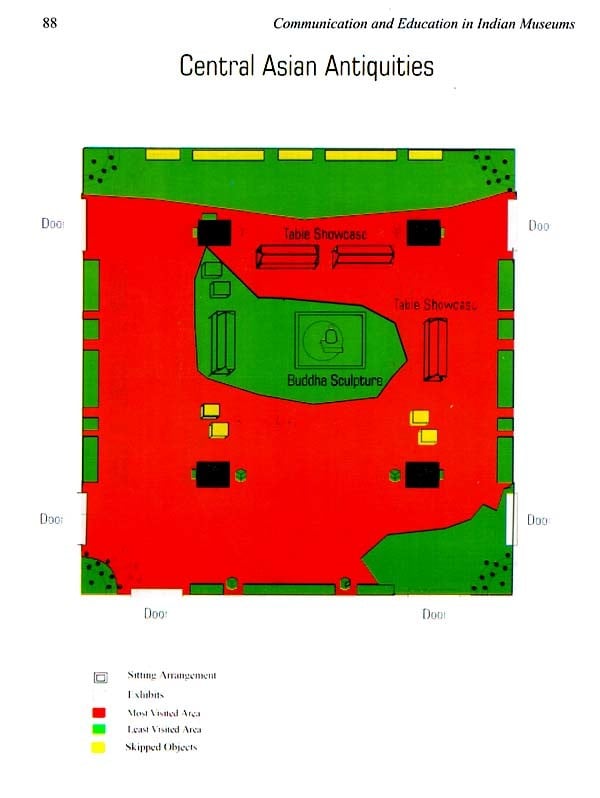
Communication and Education in Indian Museums
Book Specification
| Item Code: | AZH091 |
| Author: | Manvi Seth |
| Publisher: | AGAM KALA PRAKASHAN, DELHI |
| Language: | English |
| Edition: | 2012 |
| ISBN: | 9788173201288 |
| Pages: | 171 |
| Cover: | Hardcover |
| Other Details | 11.00x9.00 inch |
| Weight | 860 gm |
Book Description
The book traces the journey of Indian museums from the colonial to the present era pointing towards the changes in social perception of the museum and the evolution of its public service functions. It focuses primarily on art and archaeology Museums and their connection to the communication strategies. This book is an enquiry into methodology, interrelation and integration of the three independent yet connected fields of the Museology discipline, the Museum profession and the Communication science. It evaluates the working relationship of the museum profession and the discipline of Museology in India. The book emphasizes the need for a communication policy for Indian Art and Archaeology Museums with reference to revised vision, goals and aims as per the needs of Indian Visitors. It is an attempt at bringing to fore the importance of participatory communication with reference to the future of Indian museums.
At the Maharaja Sawai Man Singh II Muscum, City Palace, Jaipur she redesigned the interpretation panels of the Textile Gallery. She also published a popular weekly series, which ran for three months on 'Dying Arts and Crafts of the Erstwhile State of Jaipur' in a leading National Daily, Hindustan Times.
At the National Museum Institute she has conceptualized and coordinated research projects in the areas of Visitor Studies, Museum Education and Documentation. She has been organizing educational workshops for the underprivileged and marginalized children as templates for museums. Amongst the various exhibitions she has curated the prominent ones are - an exhibition on the Photographic collection of J. Ph. Vogel from the Kern Institute, Leiden; a Tactile Exhibition titled 'Ehasas: Senses and Images' for the visually impaired section of Museum Target Audience; and 'Astitav-a search for our identity', an exhibition on heritage awareness.
She has coordinated various in-service training programmes for museum personnel from Madhya Pradesh, Rajasthan and Ladakh. She has coordinated national and international seminars and conferences.
She has presented papers at many national and international seminars and conferences organized by bodies like Commonwealth Association of Museums, International Committee for Training of Museum Personnel, INTACH, Rajasthan University, International Conference on Oriental Carpets, Rajasthan Studies Conference, etc.
Dr. Seth is the recipient of prestigious Nehru Trust UK Visiting Fellowship. She has visited museums across India, United Kingdom, United States of America, Chile and Austria. She is a member of International Expert Review Board for Distance Learning of the Commonwealth Association of Museums (CAM). She is also on the Executive board of the Indian committee of International Council of Museums (INC-ICOM).
Wherever they are, Museums are about collection, interpretation and communication. Their physical reality is rightly considered as a representation of the shared values of maintaining a collective cultural memory. This lends them an important status in the arena of education. Today the dynamics of education lays stress on inspiring more than teaching, and hence on the principle of continuing education. In this process Museums play a vital role because of their capacity to hold original objects as also for making knowledge accessible even to the unlettered.
Contrary to their proverbial "take-for-granted" attitude, Museums today strive to go beyond information and experience into stimulating discussion not of form but of ideas behind it. Objects become meaningful only through well defined concepts, for beyond their physical form objects are associated with ideas. We need them both. Museum as an institution is in a perpetual state of metamorphosis. There is an ongoing debate between adherents of old, traditional methods of functioning and proponents of New Museology which seeks to stress purpose over functioning. I am inclined to quote here Stephen Weil's observations: "Rather than holding itself forth as authoritarian or exclusive source of historical interpretation or aesthetic judgement, the Museum would hope to enlist the visitor as a collaborator who might, in turn, develop his own sense of heritage, causality, connectedness and taste - his own links to both an individual and a communal past Today among the triology of Museology viz. collection, interpretation and communication more emphasis is being placed on communication and the visitor as an active participant in the communication process.
One recalls here the 1977 Belgrade meet of the UNESCO which stressed self management, access and participation. This was followed in 1980 by the convention of the International Commission for the study of Communication Problems which called for an understanding of the diversity and plurality "with full respect for the dignity and equality of people living in different conditions and acting in different ways" Participation for sustainable development and participatory communication were emerging ideologies. The emergence of New Museology around this period in the seventies coincides with this scenario.
Museum in present times is increasingly being conceived and perceived as an ever evolving entity, which embrace in its structure and functions the needs and trends of the time it exists in. An understanding on the part of the museum of its societal milieu and the connected material culture and heritage, both tangible and intangible, and a sense of social accountability to initiate and sustain the communication is needed to convert the museums into active community heritage centers.
The present book traces the journey of Indian museums from the colonial to the present era pointing towards the changes in social perception of the museum and the evolution of its public service functions. It analyzes the utility of present day museums and their functions in the Indian society. The book accepts the worldwide established notion of museum communication being future of the museums, the one which embraces the important public functions of exhibition and education in the meaningful context of 'medium' and 'message' respectively.
Museums are about objects and more importantly about the heritage, culture and knowledge represented by the objects. Artifact, however, important they may be, are only so because of their meaning and use. Culture varies from country to country and region to region. While the uniform set of those indispensable functions which qualifies a museum universally, have been identified by the International museum bodies and to certain extent museums, all over the world, do identify and comply with these ethical guidelines formally, however each country, each region should look towards its own museums, collections and its visitors to chalk out its goals, its mission and its list of services in order to be meaningful and communicative. Museums are progressively being viewed as the contact zones (Clifford, 1999:438) facilitating an active dialogue between the visitor and the objects. The concept is changing, the way interpretation and meaning-making use to take place in the museum. The present book moves back and forth exploring the applicability and usability of other theoretical frameworks in the context of museum and in the realm of Museology. It also looks at finding direct practical application of such academic research in the field of Indian Museums.
**Contents and Sample Pages**











